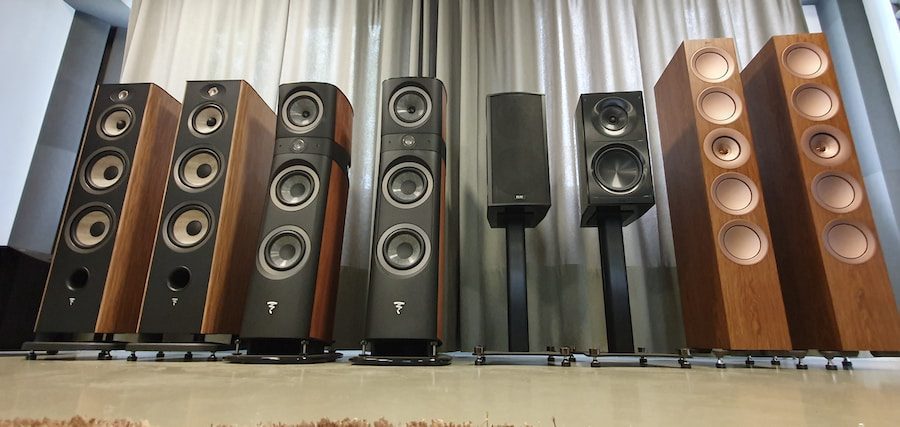When choosing speakers for a home audio system, one of the most important factors to consider is the type of driver configuration. There are two main types of driver configurations: multi-way and single-way. Both have their unique features, advantages, and disadvantages. Choosing between them is an essential aspect of building the perfect audio setup.
Multi-way speakers consist of multiple drivers designed to handle specific frequency ranges. These speakers usually comprise separate tweeters, midrange drivers, and woofers that work together to reproduce a wide range of audio frequencies. This approach allows for more precise control and accuracy in reproducing sound, improving clarity and detail in audio reproduction.
On the other hand, single-way speakers, also known as full-range speakers, utilize a single driver for reproducing the entire audio spectrum. This design simplifies the speaker system, often resulting in a more compact and easy-to-install setup. However, the performance and sound quality may suffer compared to multi-way counterparts. The single driver covers high and low frequencies, potentially limiting the speaker’s overall performance.
Table of Contents
- Understanding Speaker Drivers
- Multi-Way Driver Speakers
- Single-Way Driver Speakers
- Comparing Multi-Way and Single-Way Driver Speakers
- Choosing the Right Speaker System for Your Needs
- Last Word on Multi-Way and Single-Way Driver Speakers

Understanding Speaker Drivers
Speaker drivers are the essential components in a speaker that generate sound by converting electrical signals into sound waves. There are two primary types of speaker drivers: multi-way and single-way. Knowing the difference between these two types of speaker drivers is vital for selecting the best audio equipment to suit one’s needs.
Multi-way drivers use several drivers, each dedicated to a specific frequency band. The most common variations include:
- Two-way systems: consist of a woofer for low frequencies and a tweeter for high frequencies.
- Three-way systems: include a woofer, tweeter, and a midrange for middle frequencies.
- Four-way systems: have a dedicated driver for sub-bass frequencies and the woofer, midrange, and tweeter.
Single-way drivers, also known as full-range or single-driver systems, use just one driver to handle the entire frequency range. They aim to reproduce all the sound frequencies with a single transducer, eliminating the need for dividing the signal among several drivers. Full-range drivers can be found in smaller speakers and headphones, where space constraints make using multiple drivers impractical.
Several factors affect speakers’ performance, such as materials, design, and driver implementation. The key advantages and drawbacks of each type of speaker driver are as follows:
| Driver Type | Advantages | Drawbacks |
|---|---|---|
| Multi-way Drivers | Higher fidelity sound reproduction Each driver optimized for specific frequencies | Compromises in sound quality across frequencies Have limitations in reproducing extreme highs and lows. |
| Single-way Drivers | Simpler design Compact size | Compromises in sound quality across frequencies have limitations in reproducing extreme highs and lows. |
Multi-Way Driver Speakers
Multi-way driver speakers are designed to produce a wider range of audio frequencies by utilizing multiple speaker drivers, each responsible for reproducing a specific range of frequencies. These systems typically consist of two or more drivers, such as woofers, midrange drivers, and tweeters.
Advantages
There are several advantages to using multi-way driver speakers, which include the following:
- Better frequency response: Each driver is designed to handle a specific frequency range, resulting in a more accurate reproduction of the audio source.
- Reduced distortion: Since each driver is dedicated to reproducing a specific range of frequencies, they can be optimized for that purpose, reducing the likelihood of distortion caused by trying to produce frequencies outside their optimal range.
- Improved imaging: Using separate drivers for different frequency ranges can lead to better imaging and separation of audio elements, resulting in a more immersive listening experience.
Disadvantages
Despite their benefits, multi-way driver speakers also have some drawbacks:
- Increased complexity and cost: More drivers and additional crossover components can increase the overall complexity and cost of the speaker system.
- Potential phase issues: Using multiple drivers can introduce potential phase issues, adversely affecting the audio quality if not properly addressed during the design process.
- Larger size: In general, multi-way speaker systems tend to be larger than their single-way counterparts, which can be a concern for those with limited space for audio equipment.
In summary, multi-way driver speakers utilize separate drivers to reproduce different frequency ranges, offering better audio performance in many cases. However, they can be more complex and costly than single-way driver systems and may introduce potential audio quality issues if not carefully designed.
Single-Way Driver Speakers
Single-way (or full-range) driver speakers utilize a single driver to cover the entire audio spectrum. In this section, we will discuss their advantages and disadvantages.
Advantages
Some advantages of single-way driver speakers include simplicity, cost-effectiveness, and better soundstage imaging. Due to their simple design, full-range speakers are often easier to set up and require fewer components.
- Simplicity: With only one driver handling the entire audio frequency range, there is no need for crossovers or multiple drivers, leading to a compact and simple design.
- Cost-effectiveness: Fewer components and a simpler design often make single-way driver speakers a more affordable option for many consumers.
- Better soundstage imaging: Since all frequencies come from a single point source, there is less risk of phase issues, leading to a more coherent and realistic soundstage.
Disadvantages
Despite their advantages, single-way driver speakers have limitations, including reduced efficiency, lower maximum output, and restricted frequency range.
- Reduced efficiency: A single driver attempting to reproduce the entire audio spectrum can lead to inefficiency. A single driver may not be ideally suited to reproduce both low and high frequencies.
- Lower maximum output: Full-range speakers often have lower power handling capabilities, resulting in lower maximum output than multi-way speakers.
- Restricted frequency range: Due to the limitations of a single driver, full-range speakers may struggle to reproduce extreme lows and highs, resulting in a somewhat limited frequency range.
In summary, single-way driver speakers offer simplicity and cost-effectiveness while sacrificing some efficiency and frequency range. When choosing a speaker system, whether these trade-offs are acceptable depends on the listener’s priorities and needs.
Comparing Multi-Way and Single-Way Driver Speakers
There are two main types of speaker systems: multi-way and single-way driver speakers. This section will explore the key differences between these speaker systems, focusing on their design, performance, and ideal use cases.
Multi-way driver speakers, or multi-sound source speakers, feature multiple speaker drivers within a single unit. These speakers often have two or more drivers, such as a tweeter and a woofer, designed to handle specific frequency ranges. This design aims to optimize the reproduction of the audio spectrum.
On the other hand, single-way driver speakers utilize only one driver to reproduce the entire frequency range. This means that the single speaker must be capable of handling low, mid, and high frequencies. These systems are often more compact and provide a more focused, coherent soundstage.
- Design: Multi-way systems provide dedicated drivers for different frequency ranges, leading to better performance in those respective ranges. Single-way systems are simpler and use one driver to handle all frequencies.
- Performance: Multi-way systems often deliver superior performance, particularly in bass response and handling complex audio arrangements. However, single-way systems can sometimes provide a more focused soundstage.
- Ideal Use Case: Multi-way speakers are better suited for larger rooms, where more powerful sound is needed to fill the space. Single-way speakers can be ideal for smaller spaces or users seeking a more compact setup.
Before choosing between multi-way or single-way driver speakers, evaluating individual needs and preferences is important, considering factors such as room size, listening preferences, and budget constraints. Both systems offer unique benefits, and the choice ultimately depends on the user’s preferences and requirements.
Choosing the Right Speaker System for Your Needs
When selecting the right speaker system for your needs, several factors must be considered. These include the size of your room, your listening preferences, and your budget. Considering these factors, you can make an informed decision about whether a multi-way or single-way driver speaker might be the best option for your setup.
The size of your listening space plays a crucial role in selecting the right speaker system. Smaller rooms usually benefit from compact single-way driver speakers that produce a coherent sound. On the other hand, larger spaces may require multi-way drivers that can fill the room with sound and deliver a more expansive frequency range. Consider the dimensions of your space when choosing between single-way and multi-way driver speakers.
Your listening preferences should also be taken into account. For those who primarily listen to orchestral music, jazz, or classical genres, multi-way driver speakers can accurately reproduce a wider spectrum of musical nuances. However, if you prefer rock, electronic, or pop music, a single-way driver speaker may be sufficient to deliver the desired audio quality.
Budget is another essential factor in your decision-making process. Generally speaking, single-way driver speakers are more affordable than multi-way driver systems because of their simpler design and lower component costs. However, it is essential to balance cost and performance, as investing in a higher-quality speaker system can enhance your overall listening experience.
In summary, the decision between multi-way and single-way driver speakers depends on various factors such as your room size, listening preferences, and budget. Considering these aspects, you can choose the speaker system that best suits your needs and provides the optimal listening experience for your favorite music genres.
Last Word on Multi-Way and Single-Way Driver Speakers
Speaker systems play a crucial role in audio technology in delivering high-quality sound. There are a few key differences to consider when comparing multi-way and single-way driver speakers.
Multi-way driver speakers employ multiple drivers, each dedicated to reproducing a specific frequency range. This design offers improved sound quality and a more accurate audio reproduction. However, they can be bulkier and more expensive than their single-way counterparts.
On the other hand, single-way driver speakers utilize one driver for all frequencies, resulting in a simpler design and often a more compact form factor. Though they may not provide the same level of audio fidelity as multi-way systems, they are generally more budget-friendly and easy to set up.
Ultimately, the choice between multi-way and single-way driver speakers depends on individual preferences and requirements. Consumers must consider price, space, and sound quality before deciding. By carefully weighing the pros and cons of each system, one can find the speaker setup that best suits their needs and enhances their listening experience.
- Review of the ALABS IRON MINI-WL: A Powerhouse Wireless Microphone - October 4, 2023
- What is a Saturator in Music Production: A Brief Explanation - May 11, 2023
- What Are Rotary DJ Mixers? An Overview - May 11, 2023
SoundStudiomagic.com is a participant in the Amazon Services LLC Associates Program, an affiliate advertising program designed to provide a means for sites to earn advertising fees by advertising and linking to Amazon.com. We also participate in other affiliate programs which compensate us for referring traffic.

